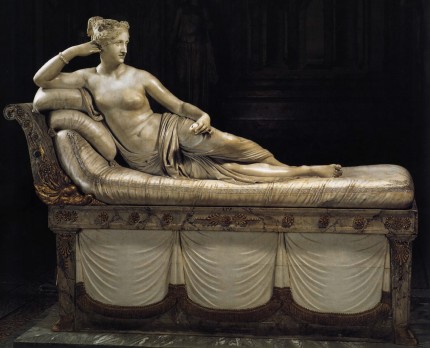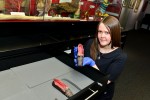 Louise Wilkie’s first major project as a curatorial assistant in the University of Aberdeen’s museums collections department was sorting through the extensive collection of objects donated to the university by alumnus and world traveler Doctor Robert Wilson (1787 – 1871). In a large travelling case filled with men’s clothes (presumably Robert’s), a beautiful wee pair of leather and silk women’s shoes caught her eye. On the sole of one of them was handwritten: “Pauline, Rome January 20th 1824.”
Louise Wilkie’s first major project as a curatorial assistant in the University of Aberdeen’s museums collections department was sorting through the extensive collection of objects donated to the university by alumnus and world traveler Doctor Robert Wilson (1787 – 1871). In a large travelling case filled with men’s clothes (presumably Robert’s), a beautiful wee pair of leather and silk women’s shoes caught her eye. On the sole of one of them was handwritten: “Pauline, Rome January 20th 1824.”
Intrigued, Wilkie checked the inventory of the Wilson collection and found them listed with no more information than was already written on the shoe itself. They were described simply as “A pair of slippers – Pauline, Rome Jan 20th 1824.” Further research into the Wilson archives revealed that the good doctor had been a close personal friend of Princess Pauline Borghese, née Bonaparte, the younger sister of Napoleon who was famous for her beauty and notorious for her vast array of lovers.
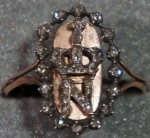 One entry in Wilson’s diary alludes to just how close they were: “I passed a fortnight in the vicinity of Pisa with the Princess Borgese [sic] in a state of almost perfect seclusion and afterwards accompanied her to the Baths of Lucca.” She gave him many presents, among them a ring of the Napoleonic N topped with the imperial crown all set in diamonds atop a locket containing Napoleon’s hair, and more intimately, a pair of her shoes.
One entry in Wilson’s diary alludes to just how close they were: “I passed a fortnight in the vicinity of Pisa with the Princess Borgese [sic] in a state of almost perfect seclusion and afterwards accompanied her to the Baths of Lucca.” She gave him many presents, among them a ring of the Napoleonic N topped with the imperial crown all set in diamonds atop a locket containing Napoleon’s hair, and more intimately, a pair of her shoes.
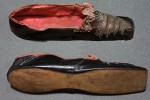 They are 21 centimeters (eight inches) long, 5.5 centimeters (2 inches) wide at the ankle and 4 centimeters (1.6 inches) across the square toe. That’s a child size 2 in the UK, 3 in the US. The outer shoe is leather with embroidered strips of mauve silk inlaid at the toe and a light pink ruffle bordering the tongue. The inside of the slipper is lined in raspberry silk. They look like they were made yesterday, the leather shiny and unscuffed, the dyes still brilliant. Being stashed in the dark, untouched, for a century and a half has kept them in very close to original condition.
They are 21 centimeters (eight inches) long, 5.5 centimeters (2 inches) wide at the ankle and 4 centimeters (1.6 inches) across the square toe. That’s a child size 2 in the UK, 3 in the US. The outer shoe is leather with embroidered strips of mauve silk inlaid at the toe and a light pink ruffle bordering the tongue. The inside of the slipper is lined in raspberry silk. They look like they were made yesterday, the leather shiny and unscuffed, the dyes still brilliant. Being stashed in the dark, untouched, for a century and a half has kept them in very close to original condition.
The luxurious indolence of the feet they once adorned doubtless played an 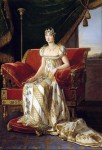 important role in keeping the shoes so pristine. Pauline was often indisposed or ill. Her family and friends thought her a hopeless hypochondriac although she certainly did have genuine physical ailments on occasion. (When she went to French Colony of Saint Domingue with her first husband General Leclerc during the Haitian Revolution she got Yellow fever. When she returned to Paris after his death from the fever, she had a sore on her hand that wouldn’t heal.) Her fragility, real or imagined, often prevented her from walking. Instead, she was carried by servants or kept to her bed/chair/divan.
important role in keeping the shoes so pristine. Pauline was often indisposed or ill. Her family and friends thought her a hopeless hypochondriac although she certainly did have genuine physical ailments on occasion. (When she went to French Colony of Saint Domingue with her first husband General Leclerc during the Haitian Revolution she got Yellow fever. When she returned to Paris after his death from the fever, she had a sore on her hand that wouldn’t heal.) Her fragility, real or imagined, often prevented her from walking. Instead, she was carried by servants or kept to her bed/chair/divan.
Laure Junot, Duchesse d’Abrantès, describes such a scene in her Memoirs of Napoleon, his court and family, Volume 2. During a party at the Napoleon and Josephine’s country home, the Château de Malmaison, the guests were enjoined to put on a diverting amateur theatrical. Pauline tried to beg off on the grounds that she was, as ever, indisposed, but Napoleon wouldn’t hear of it.
The Princess Pauline, as an actress, acquitted herself tolerably well, but her singing was so outrageously out of tune that it was scarcely endurable. It was, besides, sufficiently ridiculous to see her carried into the middle of the theatre (for the state of her health prevented her walking), and there, in her arm-chair, rehearsing the part of a young affianced bride.
Another memoir, this one by the Baronness of Montet, describes Pauline holding state in her invalid’s chair while getting a pedicure from a page boy before stunned noblewomen.
I am thinking, I know not why, of the beautiful Princess Pauline Borghese, Napoleon’s sister. Our dear Wilhelmina Hoehenegg, lady-in-waiting to the Empress [of Austria] was telling us one evening how, when at Rome with Princess Ruspoli who had given her a home after the death of her mother, the conversation turned on pretty feminine feet. Princess Ruspoli knew how frivolously vain the Imperial princess was, and did not forget to go into raptures over her foot. “Would you like to see it?” said Princess Borghese quietly. “Come tomorrow at twelve.” Great was Princess Ruspoli’s astonishment, but there was no means of escaping this peculiar invitation.
She presented herself at the Palazzo Borghese with Mme. de Hoehenegg, and was ushered into an exquisite boudoir. The Princess was reclining at her ease in an invalid’s chair, her little feet well in view; but that was not the treat in store. A page, pretty as a Cupid, and dressed as pages are in medieval paintings, entered, bearing a costly ewer, a silver-gilt basin, a napkin of fine cambric, perfumes, and other cosmetics. He drew a velvet hassock up to the chair, the Princess graciously put forth one of her legs, the page took off the stocking, the garter, too, I think, and began to massage, to rub, to wipe, to perfume this beautiful foot, which really was incomparable.
The operation was a lengthy one, and the astonishment of the lookers-on so great that they lost the faculty of enthusiastic praise which was doubtless expected of them. […] While the little page drew off, and drew on, her stockings, perfumed her beautiful feet, filed and refined the nails, she was chatting and, to all appearances, quite devoid of self-consciousness as regards her toilet.
If she was devoid of self-consciousness in front of proper aristocratic ladies, you can see why there would be no difficulty at all in her making a gift of her slippers to a close male friend and probable lover.
Robert Wilson had attended what was then Aberdeen College in the early 19th century before going to med school in Edinburgh. After graduation, he joined the East India Company as a ship’s surgeon and made a substantial amount of money on their trade voyages. When he left the service, he gave free rein to his wanderlust, traveling to, among other places, Greece, Egypt, Turkey, Palestine, Syria, India, Ceylon, China, Persia, Russia, Portugal, Spain, England, Malta, France and Italy. Along the way he made friends with famous and well-connected people like Lord Byron fighting for Greek independence, the Marquis of Hastings when he was governor of Malta, the Emperor of Russia’s personal physician and a certain Princess Borghese.
Pauline Borghese was still married to Prince Camillo Borghese when she and Wilson met in the early 1820s. They had been estranged for years by then, but the bitterness which drove them to seek a divorce after the defeat of Napoleon at Waterloo when the Prince no longer had an imperial ass to kiss had dissipated. From 1816 to her death in 1825, they lived entirely separate lives but no longer actively pursued legal separation and divorce in the Roman Rota, an appellate court mainly for civil cases brought before the Holy See for adjudication in the Papal States. Pauline lived in Rome under the protection of the Pope; Camillo moved to Florence and lived with his mistress.
When that shoe that was labeled in 1824, she was 43 years old and genuinely ailing. Her trips to health spas like the one she went to with Wilson, a frequent occurrence in her eternally-indisposed youth, took on a new meaning now. A year and a half later tuberculosis would claim her life.
Pauline Borghese’s elegant little slippers and the ring have gone on public display for the first time in the 100 Curiosities exhibit at the University of Aberdeen’s King’s Museum.
